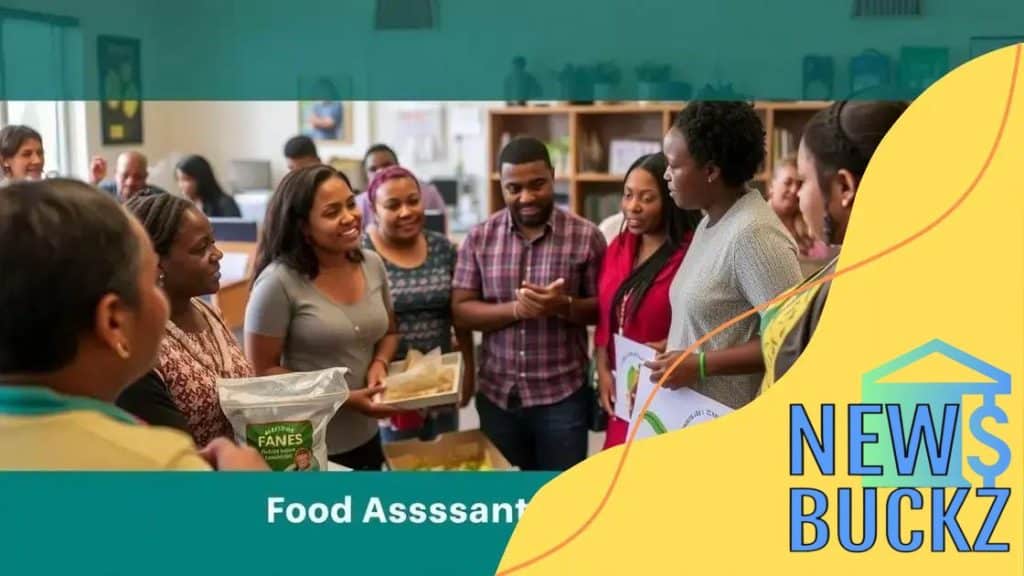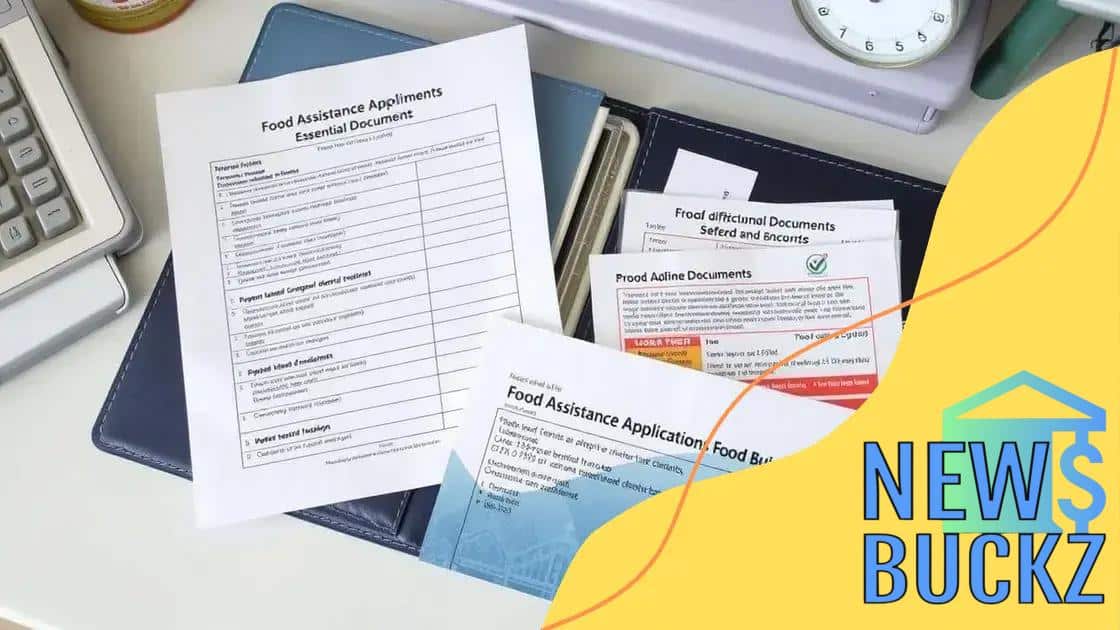How to apply for food assistance programs in 2025

Anúncios
To apply for food assistance programs in 2025, verify eligibility, gather necessary documents like proof of income and ID, and follow the specific application steps outlined by your local agency.
How to apply for food assistance programs in 2025? It’s a question many may find themselves asking as costs continue to rise. Exploring the options can be the first step toward essential support.
Anúncios
Understanding food assistance programs
Understanding food assistance programs is essential for everyone seeking help. These programs aim to provide support to individuals and families in need. By knowing the options available, you can make informed choices about applying for assistance.
What Are Food Assistance Programs?
Food assistance programs are designed to help those struggling to afford nutritious meals. They can vary by state and often include benefits like SNAP (Supplemental Nutrition Assistance Program) and food banks.
Types of Food Assistance Programs
- SNAP: Provides monthly benefits to purchase food.
- WIC: Offers support for women, infants, and children.
- Local food banks: Distribute free food to those in need.
- School meal programs: Ensure children receive meals during school hours.
Each program has specific eligibility requirements. For example, SNAP often considers household income, size, and expenses. It’s important to check which programs are available in your local area for the best support.
Anúncios
In addition to government programs, communities might offer resources like meal delivery services or food pantries. Many local organizations partner to help fill the gaps in food security, especially in challenging times.
By becoming aware of the various options under food assistance programs, individuals can find the help they need more effectively. Taking the step to learn about these resources is vital in ensuring you or your family can access healthy food.
Eligibility requirements for 2025
When seeking food assistance, it’s vital to understand the eligibility requirements for 2025. These requirements can vary greatly depending on the specific program you are applying for, so being informed is necessary.
General Eligibility Criteria
Most food assistance programs have basic criteria that applicants must meet. Typically, these include:
- Income limits: Households must demonstrate that their income falls below a specified threshold.
- Residency: Applicants must usually reside in the state where they are applying.
- Citizenship: Many programs require applicants to be U.S. citizens or qualified legal residents.
- Household size: Eligibility can depend on the number of people living in your household.
Understanding these basic guidelines can help you determine your eligibility and streamline the application process. As each program may have unique aspects, it’s essential to review the specific details.
Special Considerations
In addition to the general criteria, certain programs may have special considerations. For instance, those with disabilities or elderly individuals may find additional support or programs tailored to their needs. This can include expedited services or other considerations in the application process.
It’s essential to gather all the necessary information and documentation before applying. Common requirements include proof of income, identification documents, and proof of residence. Preparing these documents ahead of time will make the process smoother.
Don’t hesitate to reach out to local agencies, as they can provide guidance tailored to your specific situation. Understanding the eligibility requirements for 2025 can empower you to navigate the system effectively and access the assistance you need.
How to gather necessary documents

Gathering necessary documents for food assistance programs is a crucial step in the application process. Proper documentation can help you avoid delays and make your application smoother.
Essential Documents You Need
When preparing to apply, there are several key documents you should collect. These typically include:
- Proof of income: This can be recent pay stubs, tax returns, or unemployment benefits documentation.
- Identification: A valid ID such as a driver’s license or state ID is often required.
- Proof of residence: A utility bill or lease agreement that shows your name and address.
- Social Security numbers: You will need to provide Social Security numbers for all household members applying for assistance.
Make sure each document is current and clearly shows the necessary information. This can help prevent back-and-forth communications that could delay the process.
Organizing Your Documents
Creating a dedicated folder to keep your documents organized can significantly ease the process. You might consider labeling each document clearly, so it’s easy to find what you need when filling out your application.
Utilizing a checklist can also be beneficial. List all required documents and check them off as you gather them. This way, you can ensure that nothing is missed. In some cases, programs might have additional requirements, so checking their specific guidelines is wise.
Don’t hesitate to ask for help if you have questions about the required documents. Local agencies and community organizations can guide you through what is necessary. Understanding how to gather necessary documents properly is vital for a successful application.
Step-by-step application process
The step-by-step application process for food assistance programs can seem complex, but breaking it down into manageable parts makes it easier. Following specific steps will help ensure that you submit a complete application.
Step 1: Determine Eligibility
Before starting your application, check if you meet the eligibility requirements. Review the income limits and any specific conditions related to your household situation. Understanding these guidelines will save you time and energy.
Step 2: Gather Necessary Documents
Prepare the required documentation, including proof of income, identification, and residency. Having these documents ready will make the application process smoother. Refer to the previous section for a detailed list of what you need.
Step 3: Complete the Application Form
Access the application form through your state’s benefits website or local agency. Fill out the form carefully, providing all requested information. Double-check your answers to avoid mistakes that could delay the process.
Step 4: Submit Your Application
Once the application form is complete, submit it according to your state’s guidelines. This may mean sending it by mail or submitting it online. Be sure to keep a copy for your records.
Step 5: Follow Up
After submission, it’s essential to follow up to ensure that your application was received. You can often check the status online or by contacting your local office. This may help resolve any issues quickly.
Each state may have unique processes, so it’s helpful to familiarize yourself with local rules and resources. Understanding the step-by-step application process for food assistance can empower you and make the journey toward getting help more straightforward.
Resources for additional help
Accessing resources for additional help can significantly enhance your experience with food assistance programs. There are various community organizations, governmental agencies, and online platforms designed to offer support and information.
Local Food Banks and Pantries
Many communities have food banks and pantries that provide free food to those in need. These organizations often have qualifications that are less stringent than governmental programs. Most require proof of residency and sometimes proof of income.
Community Organizations
Local charities and non-profits can be excellent resources for additional help. They might offer services such as:
- Nutrition education: Classes and workshops on healthy eating on a budget.
- Meal delivery services: Especially beneficial for seniors and individuals with mobility issues.
- Crisis assistance: Help with immediate needs beyond food, like housing or utilities.
Connecting with these organizations can provide a network of support that goes beyond food assistance, allowing individuals to gain access to a wider range of services.
Online Resources
Numerous websites can help you find information about food assistance programs. Websites like Benefits.gov guide users on how to apply for various aid programs. Many states have their own online portals where you can check eligibility and apply for benefits.
Social media platforms can also be useful tools for finding local resources. Community groups often post information about food drives or pantry hours. Staying engaged online can open doors to new support networks.
By utilizing these resources for additional help, you can empower yourself and others to navigate the food assistance landscape more effectively. This knowledge not only benefits individuals but also strengthens the community as a whole.
FAQ – Common Questions About Food Assistance Programs
What are food assistance programs?
Food assistance programs provide support to individuals and families who struggle to afford nutritious meals, offering resources like SNAP and local food banks.
How do I know if I qualify for food assistance?
Eligibility typically depends on factors like household income, size, and residency. Check with local agencies to see specific requirements.
What documents do I need to apply for food assistance?
Common documents include proof of income, identification, and residency proof. Make sure to gather these before applying.
Where can I find additional help with food assistance?
Local food banks, community organizations, and online resources can provide additional support. Don’t hesitate to reach out for help.





